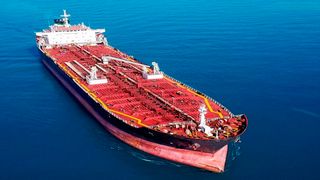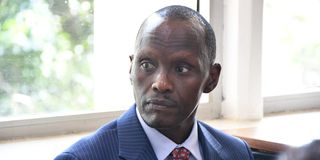
An oil tanker. Two companies are engaged in a court fight over who should claim a Sh17bn diesel consignment after offloading at the Mombasa Port.
| FileNews
Premium
Oil spills, theft, and kidnap: Terror of a crude sector
What you need to know:
- We had the case of Government-to-Government oil deal with Nigeria, and it became a big scandal
- Oil stories are frightening. It is a dirty industry and one can get kidnapped. Ask Anne Njeri.
Something is wrong with our oil industry, and unless Kenyans say no to fraudulent practices, we shall continue to pay the price. Forget the saga of Anne Njeri and the ship she claims to have brought. We have had enough stories.
Some five years ago – this week – I went to investigate a Sh1 billion ‘oil spill’ that Kenya Pipeline Company was urging the Energy Regulatory Commission to pass the loss to consumers or the insurance companies to pick the bill and compensate the oil marketers. I was shocked at the audacity to lie.
By then, the ERC was increasing fuel prices despite the crude oil prices decreasing. What Kenyans were not being told – with every increase - was that they were compensating the oil marketers for fuel that disappeared at the hands of KPC.
The oil marketers knew about the racket, but to protect their business, they had opted for silence – until they got tired.
The oil marketers had met with the KPC Managing Director, Joe Sang, at Serena Hotel on August 23, 2018, and sought explanations on how their fuel disappeared.

Businesswoman Anne Njeri Njoroge at the Mombasa Law Courts on November 14, 2023.
Mr Sang, who I later met in his office, and he personally served me with tea, had explained to the oil marketers that there was a spillage on March 2, 2017, at KM 391 where they lost 224,000 litres. They were also told that in 2018, at KM 392 and KM 395, the company had lost 1.97 million litres in a spill. At the Ngong Forest, KPC had told the marketers that 1.2 million litres of jet fuel, kerosene, and petrol got lost there in April and May 2018.
In our afternoon meeting, Mr Sang explained the same. He told me that they had been having problems in the former Head of Civil Service and Secretary to the Cabinet Prof Philip Mbithi’s Lisa Ranch in Konza, due to limestone corrosion of the pipeline. There was some PowerPoint presentation. “Can I have photos of the spillage?” I politely requested when I realised there was none in the PowerPoint. “We shall get you the images.”
Oil spillage takes many years to clean – if you have read the story of BP’s Deepwater Horizon – and the only way to verify was to go to Konza and follow the pipeline within Mbithi’s ranch, where most of the spillage was said to have occurred.
We drove and were directed to Lisa Ranch by the local residents. We were shown where the pipeline passes, and it is well marked. KM 391, where KPC claimed to have lost 224,000 litres, is by the road that leads to the ranch.
We stopped. There was no spillage, and the villagers told us they had never had any there. We moved to two other places mentioned in the letters and found no evidence of spillage.
It was now time to confirm with Prof Mbithi.

Kenya Pipeline Company Managing Director Joe Sang.
Since he fell out with President Moi, Prof Mbithi resigned to this expansive ranch and became a religious zealot.
I had known him when he was the vice-chancellor of the University of Nairobi and had interviewed him once.
It was a chance to have a word with him. As we drove into his compound with several abandoned vehicles in the parking, one could tell that the sociologist had left the fast lane.
To our luck, we saw Prof Mbithi standing by the house.
“There he is,” I told our photographer. He saw the camera and, surprisingly, entered the house. He locked himself. We sent the farm manager, Moses Parsaoti, who had opened the gate for us, with a message but still, the good-old professor did not speak to us.
The farm manager confirmed that there was some spillage at the dam and that “Haikuwa mafuta mingi”. (It wasn’t that much). “They cleaned up the dam last year (2017), and it is now in use.”
Some workers who oversaw the clean-up say that all the water was pumped out into three tankers of 40,000 litres each – meaning only 120,000 litres could have spilled there. But in total, KPC had claimed to have lost millions of litres between KM 391 and KM 397.
My next move was to check within Ngong Forest, where KPC had told the marketers that 1.2 million litres of jet fuel, kerosene, and petrol leaked between April and May 2018. Ngong is expansive, and it would have been an ecological disaster had such an oil spill occurred.
My concern was why there was a cover-up. I reached out to the Cabinet Secretary for Environment Keriako Tobiko. I sent the communication between KPC and Supplycor Kenya Limited, the independent legal entity incorporated by the oil marketing companies in Kenya, to coordinate activities along the supply chain.
Mr Tobiko sought to call “everyone” and get back to me. Within an hour, he called back: “I am hearing it for the first time. There is nobody who knows about it. I have even talked to Kenya Forest Service, and they don’t seem to know of such a spill.”
Mr Tobiko said that had it happened, it would have “caused an environmental crisis” in the forest. “We could even have made arrests,” he said. Kenya Forest Service shared a May 2018 note reporting that some KPC personnel had fallen trees within the pipeline way leaf. “We visited the site and found them carrying out repairs on the destroyed pipeline. We never saw any spillage… The forester was not informed and they fell some trees within the pipeline way leaf.”
And that is just one case.
We had the case of Government-to-Government oil deal with Nigeria, and it became a big scandal. In 1999, President Olusegun Obasanjo allowed Kenya to lift 30,000 barrels daily as part of a government policy to “find new buyers” and as “a useful way to pursue foreign policy aims”.
As Parliament was told, Kenya was to buy the oil at concessionary rates and below the OPEC basket price. At that time, Kenya purchased an average of 35,000 barrels daily for domestic use. It was expected that Kenya would have lifted oil worth $760 million.
But finally, the Ministry of Energy could only account for $40 million a year. This is what happened. When Kenya signed the deal, it knew it could not process Nigeria’s high-grade Bonny Light as its Mombasa refinery was engineered to process United Arab Emirates’ Murban.
Thus, the Kenyan quota had to be lifted and sold to any willing buyer on the spot market, a term used in the oil industry to denote those who do not buy in the speculative futures market. The unanswered question was: who lifted Kenya’s oil, and how much was sold?
“What happens is that we are given 30,000 barrels per day. If Kenya can lift that oil and refine it in our refineries for our use, then we can go ahead and do that. However, our refineries cannot meet the requirements for processing Nigerian crude oil,” Energy Assistant Minister Mwangi Kiunjuri told Parliament.
“So, instead of the Kenya Government losing that facility, it calls for tenders and tenders the facility to agents to lift the oil on its behalf. Then we get a commission, as a government, from whoever wins the tender.”
That was the explanation. When the G-to-G facility was later scrutinised on the Nigerian side, it was found to be a haven of Nigerian crude oil theft. There were middlemen “below the briefcase level” who were operating in that market as “agents,” “consultants,” or “deal negotiators.”
Finally, we had the fugitive businessman Yagnesh Devani – who left a debt trail after winning a tender to bring in fuel. He approached Glencor Energy to bring the fuel using Triton Petroleum Limited papers. With the help of Kenya Pipeline officials, and political and business connections, the fugitive managed to have 96,000 tonnes of processed petroleum worth Sh7.6 billion released to Triton without authorisation from the financiers of the cargo. He then took off leaving his financiers, who included KCB and PTA banks, Fortis Bank of Netherlands, Glencore Energy UK Limited, and Emirates National Oil Corporation (ENOC) of Singapore, running helter-skelter looking for their money.
But while these financiers may have fallen into Devani’s trap, the story of Glencore Energy is different and as it emerged later, the British company was anything but an innocent financier. The Court of Appeal ruled that Glencore had hatched an elaborate scheme to use Triton as a “front, cover and cloak” to carry out illegal oil trading in Kenya without a license – or what the judges described as a “flagrant illegality.” Devani used that loophole, siphoned the fuel, and disappeared. End of story. Oil stories are frightening. It is a dirty industry and one can get kidnapped. Ask Anne Njeri.
[email protected] @johnkamau1





